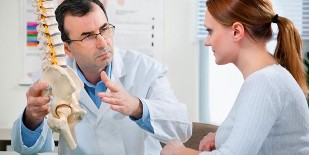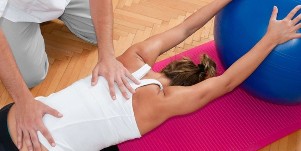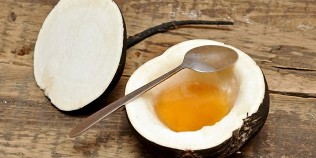In the medical literature, the term "osteochondrosis of the spine" means degenerative processes in the ossification centers in children. Behind the words sciatica, herniated disc, dorsalgia (back pain) hides a common medical disease, considered the most common among all the problems of the musculoskeletal system. The lower back, according to official statistics, suffers more often than other parts, which leads to serious complications for the whole body. Why does this happen and how to treat osteochondrosis?
What is osteochondrosis of the lumbar spine
Degenerative neuro-orthopedic disease affecting the intervertebral discs and leading to compensatory and reactive secondary changes in the osteo-ligament apparatus and nervous system: this is the definition given by doctors of osteochondrosis. It mainly affects the lumbar region, which is located between the thorax and the sacral and consists of five vertebrae. There are discs between them - fibro-cartilaginous formations, formed by the following elements:
- cartilage tissue (the membrane involved in the nutrition of the discs from the vessels of the vertebral body);
- nucleus pulposus (gelatinous mass in the center with a pulpy nucleus);
- anulus fibrosus (protects the fluid part).
Against the background of problems with blood circulation, changes in the composition of cartilage tissue, dehydration of the nucleus pulposus, the elasticity and elasticity of the intervertebral disc deteriorate, its fixing properties are affected. Under the influence of unfavorable factors, muscle fixation weakens and the vertebrae acquire excessive mobility. Subsequently, degenerative and destructive processes affect the bone surfaces of the adjacent vertebrae, there is dystrophy (tissue malnutrition) of the spine.
The further process looks like this:
- Micro-cracks appear in the loose ring. The nucleus pulposus begins to penetrate it, gradually breaks through the fibrous ring and is damaged, which leads to a herniated disc or protrusion (initial stage).
- A hernia compresses the spinal canal, which can pinch nerve roots and blood vessels, causing pain and movement problems.
- Due to the increased pressure on the vertebrae (from the thinning of the disc), an accelerated production of bone tissue begins and spinous processes (osteophytes) are formed.
Reasons
Some experts are inclined to call intervertebral osteochondrosis of the lumbar spine and others "a disease of civilization", mainly due to the upright posture, which has increased the load on the back of a modern person. Mostly the disease begins in people over the age of 30, in men it is diagnosed more often than in women.
Lumbar osteochondrosis can develop:

- excessive loads on the spine (domestic, professional, sports);
- weak back muscles;
- incorrect distribution of household load on the spine (for the lumbar spine - the most common reason);
- frequent tension of the back muscles;
- being overweight, especially against the background of diabetes mellitus;
- spinal injuries;
- violation of metabolic processes;
- incorrectly fitted shoes, flat feet;
- posture problems, which give an uneven distribution of load along the spine
- hypothermia of the lumbar spine;
- sedentary lifestyle, long-term driving;
- hormonal disorders (mainly in women);
- congenital pathologies of the musculoskeletal system;
- age (natural changes in fibrocartilage tissue occur in people over 50);
- frequent stress, emotional tension.
Degrees of development
The course of the disease is slow and gradual, with most patients only recognizing a serious problem at stage 2 or later. Without proper treatment, osteochondrosis progresses and can lead to disability.
Main medical classification:
- The initial stage is characterized by the initiation of the process of destruction of the intervertebral discs, a decrease in their elasticity, elasticity. The disease makes itself felt mainly with a load on the spine.
- Destructive processes affect the fibrous ring, the distance between the vertebrae decreases (the disc thins), depreciation is affected, protrusions appear (protrusion of the intervertebral disc without breaking the ring). Pinching of the nerve roots and inflammation of the tissues occur, which increases the pain syndrome.
- A rupture of the fibrous ring occurs, a hernia occurs. The vessels, nerve endings are compressed. Changes in the lumbar spine lead to a general deformity of the spine.
- In the last stage, the muscles of the affected section atrophy, motor activity and the ability to work suffer. The spine is noticeably bent - there is a pronounced scoliosis (3-plane deformity), lordosis (hypertrophic forward deflection of the lower back).
Symptoms of lumbar osteochondrosis
The clinical manifestations of the disease depend on the stage of severity. The main symptom is a local pain syndrome that occurs in response to physical activity, heavy lifting, hypothermia of the lower back, prolonged maintenance of an uncomfortable posture (in a sitting position, the load is greater than in a standing position). It is caused by irritation of the sinuvertebral nerve (recurrent).
The stages of osteochondrosis of the lumbar spine look like this:
- In the initial stage, there is discomfort in the lumbar region, pain is rare, mainly with a high load on the back. They pass quickly.
- In stage 2, the mobility of the lumbar spine deteriorates, pain occurs after physical exertion and without it (with a strong cough, change in posture), gradually intensifies, persists for a long time. Malfunctions in the work of internal organs are possible.
- With the development of osteochondrosis, the pains become permanent (permanent) and the vertebrae are deformed. The nerve endings are pinched, so the pain can be given to the sacrum, leg, become sharp, shoot. Loss of sensation in the limbs, buttocks, thighs, numbness, paraesthesia (burning, tingling, "chills") occur. Dysfunctions of the pelvic organs appear.
- In the last stage, motor function is impaired or becomes completely impossible, curvature of the spine occurs. The pain is permanent, the person unconsciously assumes an unnatural position to reduce it.
Reflex syndromes of the disease in mainstream medicine are included in 3 groups: muscle-tonic, neurodystrophic, vegetative-vascular. The last 2 categories clearly manifest themselves in the 3 stages of the disease and later.
The clinical picture may include:
- weakened or disappeared reflexes of the Achilles tendon, flexion of the fingers (if osteochondrosis of the sacral region is added);
- dry skin, bluish discoloration;
- urinary disorders (urinary retention or incontinence), bladder pain;
- spasms and pains in the thigh area against the background of malnutrition and blood circulation;
- tense, unsteady gait, lameness;
- increased sweating, fever with increased back pain;
- pain syndrome that radiates to the heart region (if the thoracic-lumbar region is affected).
Complications
If osteochondrosis of the lumbar spine has been diagnosed, treatment should be started immediately, as in the last stage the patient can be completely disabled. Against the background of compression (squeezing) of the spinal cord by the vertebrae, between which there is no space left, paralysis of the lower extremities can develop.
In addition, osteochondrosis can cause:
- disorders of the pelvic organs (men suffer from erectile function, women - ovarian activity);
- low back pain (acute lower back pain), sciatica (itching and inflammation of the sciatic nerve);
- prolapse of the intervertebral disc, stenosis (narrowing of the spinal canal);
- damage to the lining of the spinal cord, which is fatal.
Diagnostics
In order to make the correct diagnosis and assess the severity of the disease, the doctor collects medical history data (study of patient complaints, lifestyle, hereditary factors). Next, a physiological examination is performed, in which the patient's motor skills, posture, sensitivity level, muscle tone and size, and their spasm are assessed. By tapping with a hammer, the areas of irradiation (where it gives) pain in lumbar osteochondrosis are marked.
After patient assignment:
- Radiographyis the most accessible way to examine the anatomical parameters of the vertebrae, assess the tendency for holes between their bases to narrow, and identify bone growths.
- MRI(magnetic resonance imaging) - helps to assess the condition of the vessels that supply the spinal column, nerve processes, discs.
- CT(computed tomography) - is prescribed only to check for changes in the vessels, lining of the spinal cord, and to study marginal growths.
Treatment for osteochondrosis of the lumbar spine
Surgery is considered a last resort, mainly prescribed to patients with significant neurological disorders and at high risk of disability. These problems are characterized by advanced osteochondrosis of the lumbar spine - doctors try to carry out the treatment of stages 1 and 2 according to a conservative method.
Therapeutic measures are aimed at:
- elimination of the pain syndrome;
- removal of muscle spasms, hypertonicity;
- elimination of the inflammatory process;
- improvement of blood circulation in the affected areas and metabolic processes;
- normalization of the mobility of the lumbar vertebrae;
- restoration of lumbar sensitivity.

There is no universal treatment method: each specific case of osteochondrosis requires an individual scheme. It is especially important to take into account the form of the disease: acute or chronic. Therapy is necessarily of a combined nature, which involves the use of drugs (internally and externally) along with physical manipulations: massage, gymnastics, physiotherapy. The treatment regimen for osteochondrosis of the lumbar spine can be supplemented with acupuncture, hirudotherapy.
The effectiveness of the treatment will increase if you follow the following rules:
- Wear a special belt or corset during treatment to reduce stress on the spine.
- Physical activity is excluded (only those recommended by the doctor remain), so as not to add provocative factors.
- It is important to carefully monitor the diet: cartilage needs sources of collagen (gelatin, gelatin, jellied meat), and the whole body needs plant foods, fish, nuts. It is advisable to refuse salty, smoked, pickled products, as well as spicy cheeses, fatty meat.
- The scheme prescribed by the doctor must be followed to the end: do not stop treatment when the main symptoms have subsided, do not change the set of drugs and procedures yourself.
- Together with the doctor, it is worth choosing an orthopedic mattress that will help relax the lower back during sleep and special shoes. Women are completely forbidden from wearing heels.
Acute osteochondrosis of the lumbar spine requires special attention: its treatment begins with the appointment of the patient to bed rest for several days. Pain sensations are reduced by analgesic injections, novocaine blockade and glucocorticoids are not excluded. Spinal traction (using a traction table or vertical appliance), walking with crutches, electrophoresis, and laser therapy help improve the condition.
Drug therapy
Medicines for the treatment of osteochondrosis of the lumbar spine are used internally and locally. Local gels and ointments are symptomatic therapy: relieve inflammation and pain, relieve muscle spasm and edema, improve blood circulation. In acute conditions, injections are shown that have an immediate anti-inflammatory, antipyretic, analgesic effect.
:Most doctors prescribe home medications for osteochondrosis:
- Chondroprotectors- protect cartilage tissue and promote its recovery, are indicated for long-term use (six months or more).
- Means that improve blood circulation and metabolic processes in the tissues- tablets that are taken for several months, as the effect is cumulative.
- Muscle relaxants- relieve muscle spasm, are used orally in a short course.
- Non-steroidal anti-inflammatory- quickly blocks pain, suppresses the production of prostaglandins involved in the inflammatory process. Ointments and gels are applied to the affected area 1-2 times a day, unless otherwise indicated in the instructions. In the initial stages, it is possible to give up external forms, after which they are duplicated with tablets.
- Corticosteroids- injections for pain relief are prescribed only in the absence of a significant effect of non-steroidal drugs.
- Ointments that have a warming effect- help relieve pain and improve blood circulation in the tissues, are safer than non-steroidal drugs, but are prohibited in the inflammatory process.
- Vitamins of group Band multivitamin complexes are prescribed long-term to increase the overall effectiveness of the treatment.
Physiotherapy procedures
In order to enhance the effect of drug treatment and accelerate recovery, the patient may be prescribed physiotherapy courses. You can alternate them or go through several options at the same time. The specific technique is selected based on the stage and form of the disease.
Osteochondrosis of the lumbar spine - treatment includes effective methods:
- Electrotherapy (electrophoresis)- involves the effect of low-power electric currents to improve blood circulation in the affected areas.
- Laser therapy- activates biological processes in the nerve endings, relieves the symptoms of neuro-dystrophic syndrome.
- UHF- local impact on the lumbar region with a high frequency magnetic field to stop the inflammatory process, stimulate cell regeneration (restoration) of tissues and reduce pain.
- Phonophoresis and electrophoresis- helps deliver drugs to the area that needs them, which increases the effectiveness of drug treatment. The result depends on the specific agent used during the procedure.
- Darsonvaluation- a therapeutic effect of high frequency alternating current to expand blood vessels, improve blood circulation and tissue nutrition. The procedure affects symptoms less than others.
- Amplipulse- local effect of sinusoidally modulated currents, due to which the severity of pain is reduced. The procedure has an analgesic, vasodilator, neurostimulating effect, improves tissue trophism.
Corrective gymnastics
Physical activity - especially when it comes to early osteochondrosis (initial phase) of the lumbar spine - must be included in the treatment: they help to relax the muscles and strengthen them, have a beneficial effect on tissue nutrition. For people with Grade 2 disease and more intense exercise, a doctor will select it. With exacerbation, gymnastics, swimming, yoga (the most effective indications) are prohibited.
The following exercises show good results:
- Emphasize your knees and palms, keep your back straight (parallel to the floor). On exhalation, slowly bend the lumbar region, tilt your head back slightly. Count to 5-8 (depending on how you feel), take a breath and arch your back with a wheel. Count to 5-8 again and take the starting position. Exercise is performed 10-12 times at a slow pace. If necessary, they are divided into 2-3 approaches.
- Lie on your stomach. As you exhale, slowly lift your chest off the floor, bending in your lower back and trying to get up as high as possible. The arms are extended forward, the legs do not move. Hold this position for 5-10 seconds and gradually come down. Repeat the exercise 8-10 times, gradually increasing the duration of the delay at the highest point.
Massage
Massage is an effective method of treating any stage of osteochondrosis, which helps relieve unpleasant symptoms, remove muscle spasms and normalize lymphatic outflow and blood supply to affected areas. In addition, this procedure stimulates the restoration of atrophied muscles and removes the limitation of the mobility of the vertebrae, strengthens the ligament apparatus. The massage is performed by a specialist doctor in cycles of 10-12 sessions when the symptoms of the acute phase have subsided.
Surgery
If a patient is diagnosed with significant neurological disorders, loss of control over urination, severe hernial protrusion is present, surgery is required. In addition, the indication is the lack of a positive effect from conservative treatment (lasting more than a month). Before receiving a referral for surgery, the physician should weigh all risks, especially if traditional technology is chosen over microdiscectomy.
During the procedure, the surgeon can:
- removes the pathologically altered areas by placing local implants on them (discectomy), which are developed individually for each patient;
- to align the spine with a special rod - this helps to properly distribute the load and prevent new deformations.
Discectomy is performed under general anesthesia, access for the surgeon is posterior. During the operation, the skin is cut to a length of 10 cm, the muscles are pulled apart and the affected disc is removed. At the end of the procedure, the wound is sutured in layers. The duration of the surgery is about 2 hours, the next day the patient should lie on his back. The rehabilitation period is 2 months. With microdiscectomy, the procedure takes 1. 5 hours, a 3 cm incision is made, and you can get up after leaving the anesthesia.
Treatment of osteochondrosis of the lumbar spine with folk remedies

After consulting a doctor who can correctly assess the patient's condition, it is allowed to use the recipes of traditional medicine. They do not give the same pronounced effect as drug therapy, do not replace physiotherapy, massage and gymnastics, but increase the likelihood of a positive result from the main treatment.
Some simple options:
- Grate the peeled black radish (350g), combine it with liquid honey (250g) and vodka (100ml). Use to massage the lower back with light massage movements for 10 minutes in the morning and evening. After that, it is recommended to wrap this area with a woolen cloth and lie down for an hour under a blanket. The procedure is carried out for 8-10 days, after which they take a break.
- With severe lower back pain, you can take 100 g of medium-fat cottage cheese, add 1 tsp. apple cider vinegar, lay it on a cotton cloth or gauze. The bandage is kept for 2 hours, the procedure, if necessary, is repeated 2 times a day. The duration of treatment is not limited.
- Collect the fresh lilac flowers, fill a liter jar with them, without crushing them. Pour a liter of vodka, leave in a cold place for 3 weeks. Use to scrub the affected area once a day for a month. It is not necessary to cover the lower back with anything after processing.
Prevention of osteochondrosis of the lumbar spine
Doctors claim that most back diseases can be prevented through regular physical activity, which strengthens muscles, improves blood circulation and tissue nutrition. Osteochondrosis of the lumbar spine is no exception - treatment will not have to be done if you systematically engage in gymnastics, yoga and swimming.
Additional preventive measures:
- diet control (more plant foods, less animal fats, pickles, marinades: as in the treatment)
- limit heavy loads on the spine;
- monitor the state of the endocrine system;
- elimination of bad habits (alcohol, smoking);
- use of an orthopedic mattress;
- posture monitoring;
- avoiding high heels (7cm) for women.


























